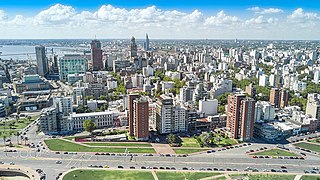Related Research Articles
The history of Uruguay comprises different periods: the pre-Columbian time or early history, the Colonial Period (1516–1811), the Period of Nation-Building (1811–1830), and the history of Uruguay as an independent country (1830–present).

Montevideo is the capital and largest city of Uruguay. According to the 2011 census, the city proper has a population of 1,319,108 in an area of 201 square kilometers (78 sq mi). Montevideo is situated on the southern coast of the country, on the northeastern bank of the Río de la Plata.

José Gervasio Artigas Arnal was a soldier and statesman who is regarded as a national hero in Uruguay and the father of Uruguayan nationhood.

The national flag of Uruguay, officially known as the National Pavilion, is one of the three official flags of Uruguay along with the flag of Artigas and the flag of the Treinta y Tres. It has a field of nine equal horizontal stripes alternating white and blue. The canton is white, charged with the Sun of May, from which 16 rays extend, alternating between triangular and wavy. The flag was first adopted by law on 18 December 1828, and had 19 alternating stripes of white and blue until 11 July 1830, when a new law reduced the number of alternating stripes to nine. The flag was designed by Joaquín Suárez.

Manuel Ceferino Oribe y Viana was the 2nd Constitutional president of Uruguay and founder of Uruguay's National Party, the oldest Uruguayan political party and considered one of the two Uruguayan "traditional" parties, along with the Colorado Party, which was, until the 20th century, its only political adversary.

The Catholic Church in Uruguay is part of the worldwide Catholic Church, under the spiritual leadership of the pope.

Plaza Independencia is the most important city square in Montevideo, Uruguay, laid out in the 19th century in the area occupied by the Citadel of Montevideo. In its center is a monument to General José Gervasio Artigas, and below it, his mausoleum.

The following outline is provided as an overview of and topical guide to Uruguay:

The National Navy of Uruguay is a branch of the Armed Forces of Uruguay under the direction of the Ministry of National Defense and the commander in chief of the Navy.

Jonas Halstead Coe, sometimes given in Spanish as Comodoro Juan Coe, was an American-born naval commander, notable in the early naval history of Argentina and Uruguay.

Paraguay and Uruguay established diplomatic relations on April 6, 1845. Paraguay has an embassy and a consulate-general in Montevideo. Uruguay has an embassy and a consulate-general in Asunción. Paraguay also has an honorary consulate in Punta del Este. Both countries were founding members of the Mercosur, and both are full members of the Rio Group, the Latin Union, the Association of Spanish Language Academies, the Organization of American States, the Organization of Ibero-American States, the Union of South American Nations, the URUPABOL, the Cairns Group and the Group of 77.

Spain–Uruguay relations are the current and historical relations between Spain and Uruguay. There is community of 67,000 Spanish nationals residing in Uruguay and 33,000 Uruguayan nationals residing in Spain. Both nations are members of the Association of Spanish Language Academies, Organization of Ibero-American States and the United Nations.

Uruguayans are people identified with the country of Uruguay, through citizenship or descent. Uruguay is home to people of different ethnic origins. As a result, many Uruguayans do not equate their nationality with ethnicity, but with citizenship and their allegiance to Uruguay. Colloquially, primarily among other Spanish-speaking Latin American nations, Uruguayans are also referred to as "orientals [as in Easterners]".

Artiguism is the set of political ideas, economic and social, of José Gervasio Artigas, the main leader of the Oriental Revolution held in the Oriental Province of the United Provinces of the Río de la Plata, which was a predecessor of the modern Republic of Uruguay.

There is a community of Americans living in Argentina consisting of immigrants and expatriates from the United States as well as their local born descendants. There are roughly 5,000 or 60,000 Americans living in the country.

Immigration to Uruguay began in several millennia BCE with the arrival of different populations from Asia to the Americas through Beringia, according to the most accepted theories, and were slowly populating the Americas. The most recent waves of immigrants started with the arrival of Spaniards in the 16th century, during the colonial period, to what was then known as the Banda Oriental.
Dominican Uruguayans are people born in the Dominican Republic who live in Uruguay, or Uruguayan-born people of Dominican descent.
Venezuelan Uruguayans are people born in Venezuela who live in Uruguay, or Uruguayan-born people of Venezuelan descent.
Ana María del Carmen Ribeiro Gutiérrez, known as Ana Ribeiro, is a Uruguayan historian, writer, and professor. Her works are based on essays and novels that relate historical events of the country.

Guido Manini Stratta is an Uruguayan politician and retired general officer who served as Commander-in-Chief of the National Army, serving in this post from 1 February 2015 until being sacked by the president on 12 March 2019.
References
- 1 2 3 John Street, Artigas and the Emancipation of Uruguay (London: Cambridge University Press, 1959), 178-186.
- ↑ Historia y Arqueologia Marítima -Garibaldi: Combate de Costa Brava(in Spanish)
- ↑ Blum, William: Killing hope: US military and CIA interventions since World War II. Zed Books, 2003, page 201. ISBN 1-84277-369-0, ISBN 978-1-84277-369-7
- ↑ "Immigration to Uruguay" (PDF). INE. Archived from the original (PDF) on 16 August 2013. Retrieved 6 March 2013.(in Spanish)
- ↑ "Foreign workers in Uruguay". EL PAIS. Archived from the original on 5 November 2013. Retrieved 4 November 2013.(in Spanish)
- ↑ Uruguayans coming back
- ↑ "Uruguay has 77,000 immigrants". Montevideo.comm. 17 June 2013.(in Spanish)
- ↑ Urwicz, Tomer (29 August 2018). "Children from 62 countries at Uruguayan schools" (in Spanish). EL PAIS.
- ↑ Uruguayan American School